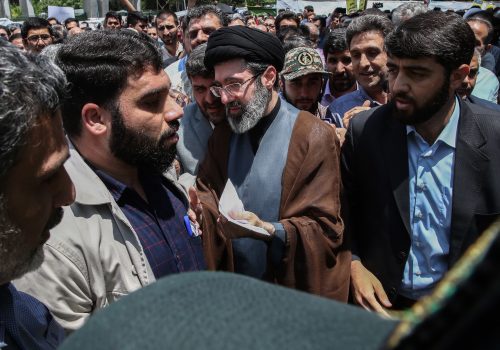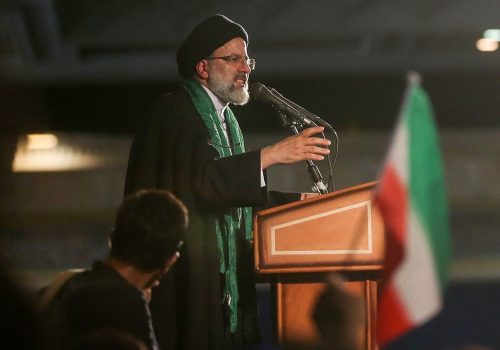The Supreme Leader is still alive. But when he does eventually die, how will succession play out?
In the past week, rumors proliferated that Iran’s Supreme Leader, Ayatollah Ali Khamenei, had died.
On September 17, however, Khamenei, eighty-three, re-emerged briefly to address a group of students, putting the rumors to rest following a two-week period in which he had not been seen in public and had canceled several scheduled appearances.
The reports about his poor health and possible demise aroused curiosity about who would succeed Khamenei and how the process might unfold.
In Iran, there are legal procedures and then there is realpolitik.
According to the constitution, the Assembly of Experts—a group of eighty-eight senior clerics vetted by another clerical body and then approved in popular elections—picks a new Supreme Leader when the incumbent dies or is otherwise incapacitated. In reality, a decision so important to the continued existence of the Islamic Republic and its elite is determined in advance and in secret.
The post of Supreme Leader is unique in the Muslim world, where secular figures are generally in charge and there is a separation between mosque and state. The position was created by and for the leader of the 1979 Islamic revolution—Ayatollah Ruhollah Khomeini—and grants massive powers to its occupant. The system, conceived by Khomeini while in exile in the 1960s and 1970s, is known as Velayat-e Faqih or rule by the jurisprudent. The leader is commander-in-chief of the armed forces, appoints the heads of all military branches and the head of the judiciary, and has the final say on all important policies. The Supreme Leader also appoints half the members of the Guardian Council, a twelve-man body that controls Iranian politics by vetting candidates for elected office, including the Assembly of Experts, presidency, and parliament.
In its forty-three-year history, the Islamic Republic has only had one prior transition for Supreme Leader, which occurred after Khomeini’s death in 1989. Khomeini had appointed a successor, Ayatollah Hossein Ali Montazeri, a respected religious authority and supporter of the revolution. But Khomeini changed his mind at the last minute after Montazeri harshly criticized the leader for authorizing the summary execution of 4,500 to five thousand political prisoners in 1988 at the end of the 1980-1988 Iran-Iraq War. Montazeri was dismissed and later put under house arrest. No new successor was named.
When Khomeini died, the Assembly of Experts was nominally tasked with choosing a successor, rather like the choice of a new pope by the Roman Catholic College of Cardinals. But Ali Akbar Hashemi Rafsanjani, the powerful speaker of the parliament at the time and a close associate of Khomeini for decades, engineered the ascension of the then president of Iran, Ali Khamenei, behind the scenes. The constitution was amended to allow for a Supreme Leader with less than stellar religious credentials (Khamenei was only a Hojatolislam or midranking cleric at the time), the post of prime minister was eliminated, and the presidency—then a weaker position—was given executive authority. The Assembly of Experts approved Khamenei, who resigned the presidency. Rafsanjani then ran successfully for president twice.
Initially the more dominant figure, Rafsanjani lost power over time, as Khamenei—elevated to “ayatollah” status after his selection—grew comfortable in his new role. Khamenei cultivated the Islamic Revolutionary Guard Corps (IRGC) in particular, compensating for his lack of clerical knowledge and popular appeal. The IRGC has since become such a major force in Iran—in the economy as well as in the security establishment—that it likely has an even bigger say in who becomes Supreme Leader than the Assembly of Experts or other elite groups.
For years now, there have been rumors that a short list of names was being considered by a small committee within the Assembly of Experts. The Atlantic Council wrote about the contenders in 2019 in an issue brief—“After Sistani and Khamenei: looming successions will shape the Middle East”—that also looked at possible successors to Ayatollah Ali Sistani in Iraq. Of the six men listed at the time as possible successors to Khamenei, one has died—former minister of intelligence Mohammad Reyshahri—and three—Hassan Rouhani, a former president, Hassan Khomeini, a grandson of the first Supreme Leader, and Sadegh Larijani, a former head of the judiciary—have been sidelined for various political reasons. That has left only two individuals: the current president of Iran, Ebrahim Raisi, and Khamenei’s second son, Mojtaba.
Raisi, who was elected in June 2021 by the lowest percentage of supporters in the history of the Islamic Republic, has struggled to achieve popularity. Raisi is burdened by his background as one of the prosecutors who signed off on the summary executions of the 1980s and was also brutal as the appointed chief of the judiciary before he became president. At this time of writing, Iran has failed to return to compliance with the 2015 nuclear deal, and its economy remains hobbled by sanctions as well as endemic corruption and mismanagement. The Raisi administration has also been extremely repressive, crushing demonstrations, arresting opponents ranging from filmmakers to bus drivers, and intensifying harassment of women who “violate” hijab. On September 16, a young woman, Mahsa Amini, was killed by the so-called morality police who arrested her, setting off new nationwide protests and international outrage.
The other candidate for Supreme Leader, Mojtaba Khamenei, also has a bleak human rights background. He rose to prominence in 2009, orchestrating the election fraud that gave then-President Mahmoud Ahmadinejad a second term and managing the repression of the post-election protests known as the Green Movement. Mojtaba is extremely close to the leaders of the IRGC and also intimately knows the financial networks under the control of the Supreme Leader. This has made some believe that Mojtaba has long been tapped to succeed his father, however awkward that would look in a country that experienced a bloody revolution to overturn two millennia of monarchical rule. It is telling that, just in recent weeks, Mojtaba—not a noted religious scholar like his father—has been referred to as an ayatollah.
Whoever succeeds Khamenei, that person will have been thoroughly vetted for loyalty to the Islamic Republic and its practices. But a change at the top will still open the prospect for a different approach over time—if only because Iran’s region and the world at large are not static. The Iranian people have also evolved considerably since the 1979 revolution and will put pressure on any new leader to somehow accommodate those changes.
Barbara Slavin is the Director of the Future of Iran Initiative at the Atlantic Council. Follow her on Twitter: @BarbaraSlavin1.
Further reading
Wed, Sep 7, 2022
Rumors of Mojtaba Khamenei being crowned with the Supreme Leader’s turban have been circulating for years. Now it may happen.
IranSource By
As President Ebrahim Raisi has stumbled, the prospects of the only other likely candidate for Supreme Leader have advanced. Attention is now focused on Ayatollah Ali Khamenei’s second son Mojtaba, who seemed from the outset to be orchestrating Raisi’s presidency.
Tue, Jun 1, 2021
A Raisi presidential win may be his undoing as future Supreme Leader
IranSource By
Conventional wisdom is that the election will facilitate Ebrahim Raisi’s ascent to the real decision-making post in Iran—that of Supreme Leader. But nothing is ever certain in Iran’s contentious politics.
Tue, Jun 22, 2021
An uncertain future for Iran under a minority president
IranSource By
On June 21, 2021, the Atlantic Council’s Future of Iran Initiative hosted an event to discuss the implications of Iran’s June 18 presidential elections for US-Iran relations. Read the key takeaways.
Image: Iran's Supreme Leader Ayatollah Ali Khamenei, attending a ceremony marking the Arbaeen, which marks 40 days after the holy day of Ashura commemorating the seventh century killing of the Prophet Mohamed's grandson Imam Hussein ibn Ali, in the capital Tehran. The American newspaper "New York Times", citing the report of knowledgeable sources in Iran, had announced that Iran’s supreme leader, Ayatollah Ali Khamenei, was in a hospital bed after falling extremely ill last week, and was currently being cared for by a team of trusted doctors. Tehran. Iran. September 17, 2022 Photo by Salampix/ABACAPRESS.COM


